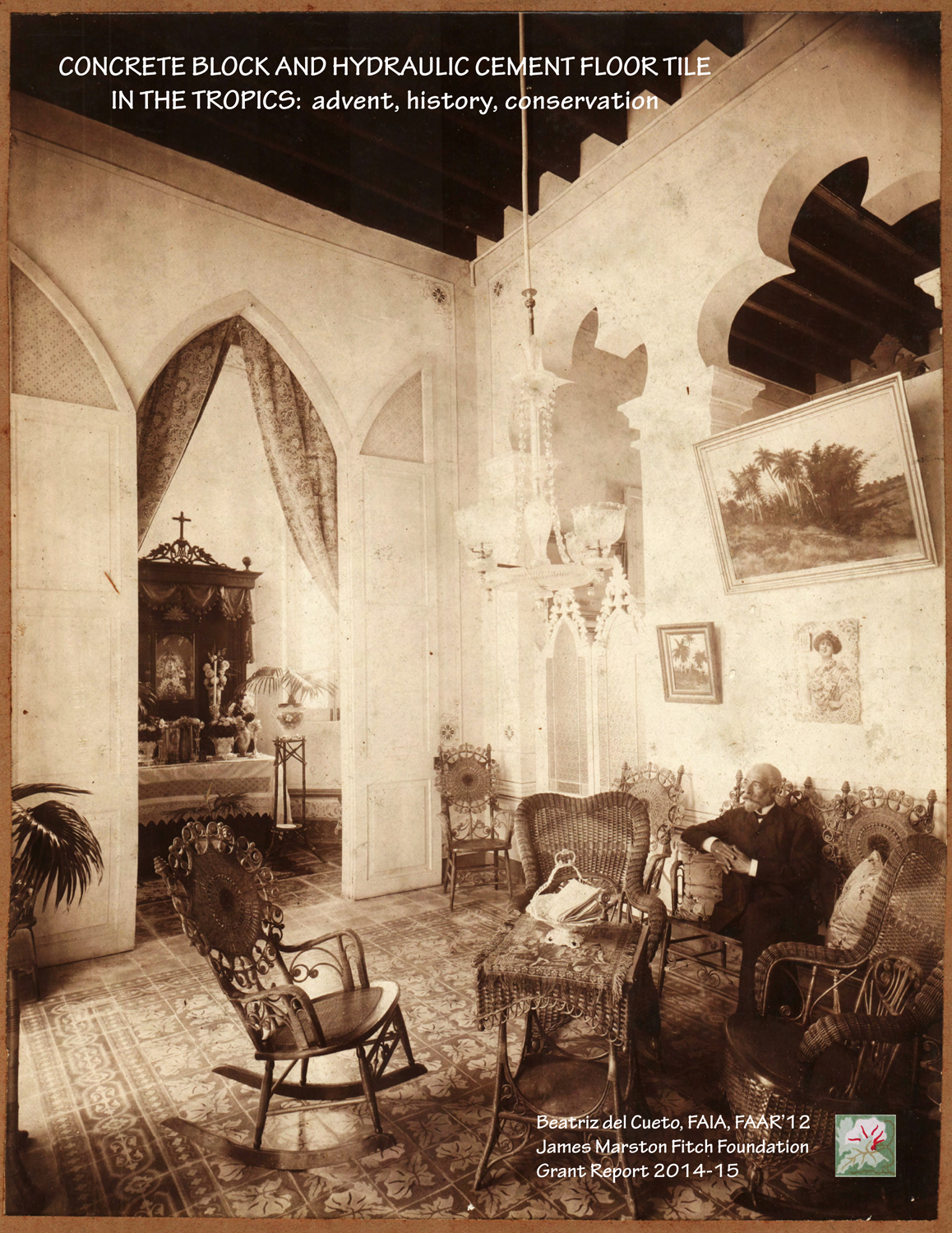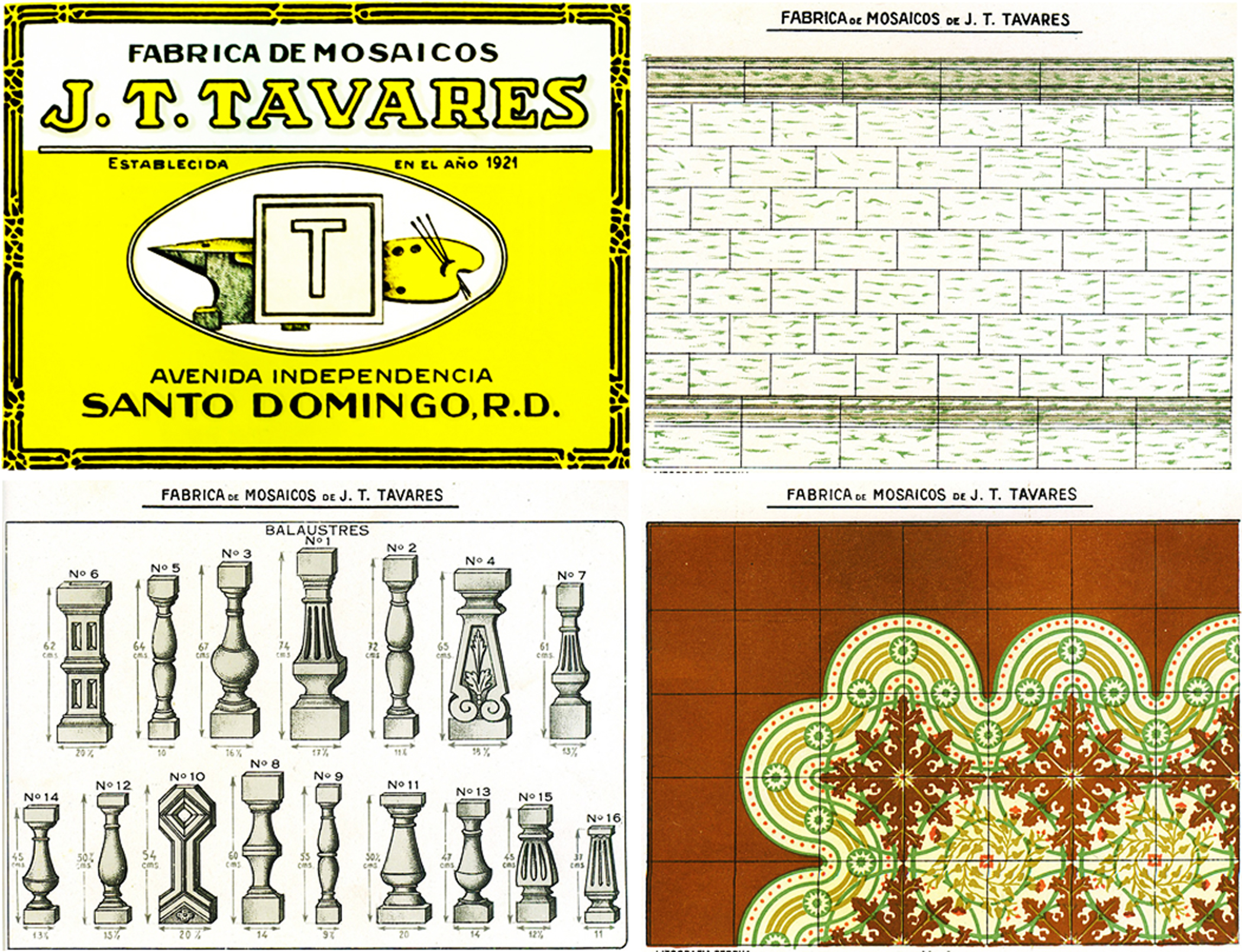In 2014, Beatriz del Cueto received a James Marston Fitch Mid-Career Fellowship. Over twelve months and across three tropical islands, Ms. del Cueto investigated the use of concrete block and hydraulic cement floor tile in the Dominican Republic, Puerto Rico and Cuba. The Fitch Foundation is proud to have supported Ms. del Cueto’s investigation and looks forward to her findings being introduced into the professional dialogue (she is now considering opportunities for publication).
Concrete Block and Hydraulic Cement Floor Tile in the Tropics: Advent, history, conservation
Project summary, by Beatriz del Cueto, FAIA, FAAR
 This research project was started during the month of April 2014 and completed during June 2015 thanks to the generosity of the James Marston Fitch Charitable Foundation Mid-Career Grants who provided the seed money to make it possible. These investigations took me to archives and libraries of the United States, Cuba, the Dominican Republic (eastern part of Hispaniola), and Puerto Rico, as well as essential site visits in order to document the extant fabric of these building materials and technologies which were the focus of this year-long project. My deepest appreciation for the help and collaboration I received from every single place I visited and the amazing and dedicated people I met along the way.
This research project was started during the month of April 2014 and completed during June 2015 thanks to the generosity of the James Marston Fitch Charitable Foundation Mid-Career Grants who provided the seed money to make it possible. These investigations took me to archives and libraries of the United States, Cuba, the Dominican Republic (eastern part of Hispaniola), and Puerto Rico, as well as essential site visits in order to document the extant fabric of these building materials and technologies which were the focus of this year-long project. My deepest appreciation for the help and collaboration I received from every single place I visited and the amazing and dedicated people I met along the way.
The late 19th and early 20th century building trades were transformed by Portland cement products that promised “quick” beauty and efficiency, and required relatively little previous experience in their manufacture or installation. Some of these products were initially advertised, and gained popularity through European Expositions and American Trade Fairs, and reached the Caribbean region by the 1880s. The new Portland cement architectural elements were advertised as permanent materials in the catalogs of important large enterprises in Europe and the United States. As a consequence, highly ornamental hydraulic cement floor tile (or mosaics), and hollow-core concrete blocks, became part of the vocabulary for residential, religious, and institutional architecture in the Spanish Caribbean during the first decades of the 20th century.
The innate characteristic of Portland cement, of setting especially well in an extreme wet and humid climate as well as in hot weather, made it the perfect material for the molded fabrication of innovative cement products in tropical regions. The relative simplicity of the process, which required no ovens, artificial heat, nor large manufacturing areas, facilitated local production of these building materials. The hydraulic mosaic and the concrete block accelerated building methods and contributed to producing new permanent tropical buildings which could resist hurricanes and earthquakes. The establishment of local Portland cement producing plants in the Spanish Caribbean by the late 19th century, facilitated and spread the use of cement as an important and indispensable building material associated with progress.
Prefabricated Portland cement building materials, specifically, the hydraulic mosaic tiles and concrete blocks, played a key role in the architecture of the late 19th and early 20th centuries on the three islands of the Spanish Caribbean: Cuba, the Dominican Republic and Puerto Rico. The use of these building materials not only marked technological advances in construction processes, but defined the style of a time and a place – the tropical Caribbean. The material properties of these architectural elements revolutionized building methods in the region; particularly those of being fire-proof, water-proof and vermin-proof, in addition to their prefabrication possibilities, standardization as well as the speed in their manufacturing and installation processes. The history of these materials exhibit common origins in the three islands – a Catalan origin in the late 19th century, amplified by a growing United States’ influence after the Spanish-American War of 1898, and a subsequent economic boom, due to the exploitation of and prosperity brought about by sugarcane.
Both construction materials, would meet face to face or coincide in a tropical region that represented the crossroads between worlds, concurrently accepting all influences. These imported building technologies from Catalonia and the United States were mixed in the Spanish Caribbean, where they were used together or independently. As unique examples, the resulting architecture would exhibit new ways of using imitation, molded, and prefabricated Portland cement building materials that would survive indefinitely. The study and documentation of these materials and technologies will serve as indispensable tools for the preservation and conservation of buildings of this period in the Spanish Caribbean. It is important to note that the original specifications and recommendations of the early 20th century for the preservation and maintenance of these materials are as relevant today as when they were written over a hundred years ago. Herein lies the key to their survival over time.
Early 20th century building technologies have been understudied, specifically in the tropical Caribbean. Structures from this period that have survived have been mostly neglected and ultimately demolished for lack of historic relevance or as a result of ever-changing architectural tastes. The present study will promote a better understanding of the significant role these building elements played in changing the face of tropical architecture, particularly that of the Spanish Caribbean: Cuba, the Dominican Republic, and Puerto Rico, and, serve to generate consciousness for the appropriate and compatible preservation of extant examples.
PHOTOS
(1) Cuba: Interior of a 19th century residence in Havana which shows the substitution of its original wooden floors with hydraulic mosaic pavements from the “La Cubana” Factory ca. 1903. (Private Collection, La Habana)
(2) Dominican Republic: Images from Catalog No. 2 of the Mosaic Factory J. T. Tavares in Santo Domingo illustrating the assorted architectural elements manufactured using artificial stone or Portland cement by the company. (Tavares 1931)
(3) Puerto Rico: The Santiago Palmer Graded School was the first school built in Puerto Rico using concrete block during 1907. (Gráfico – Revista Semanal Ilustrada 1914)


